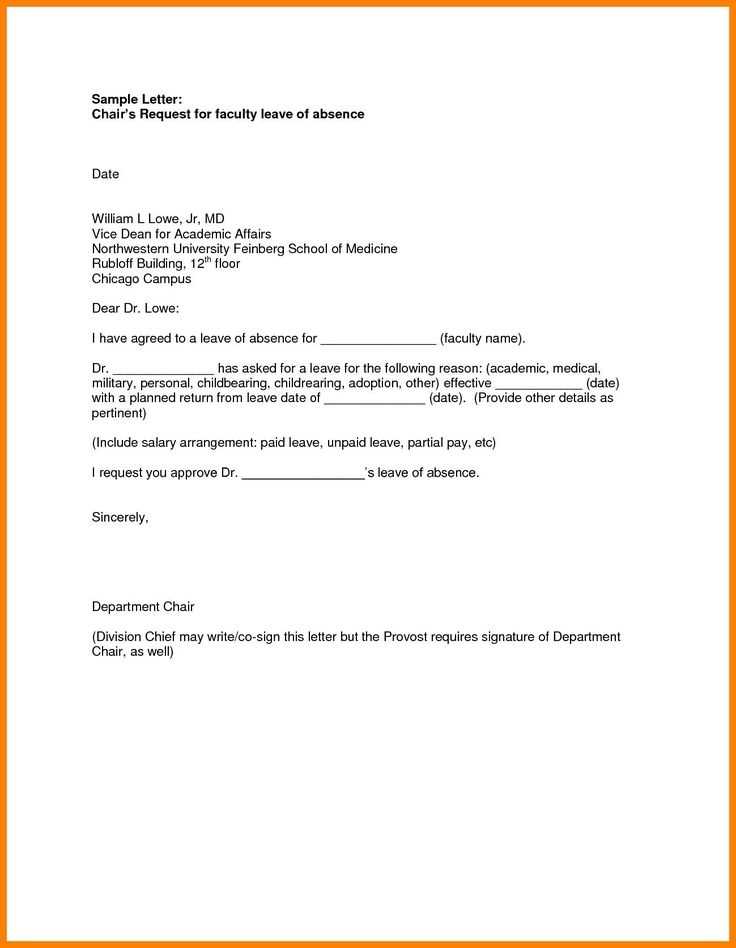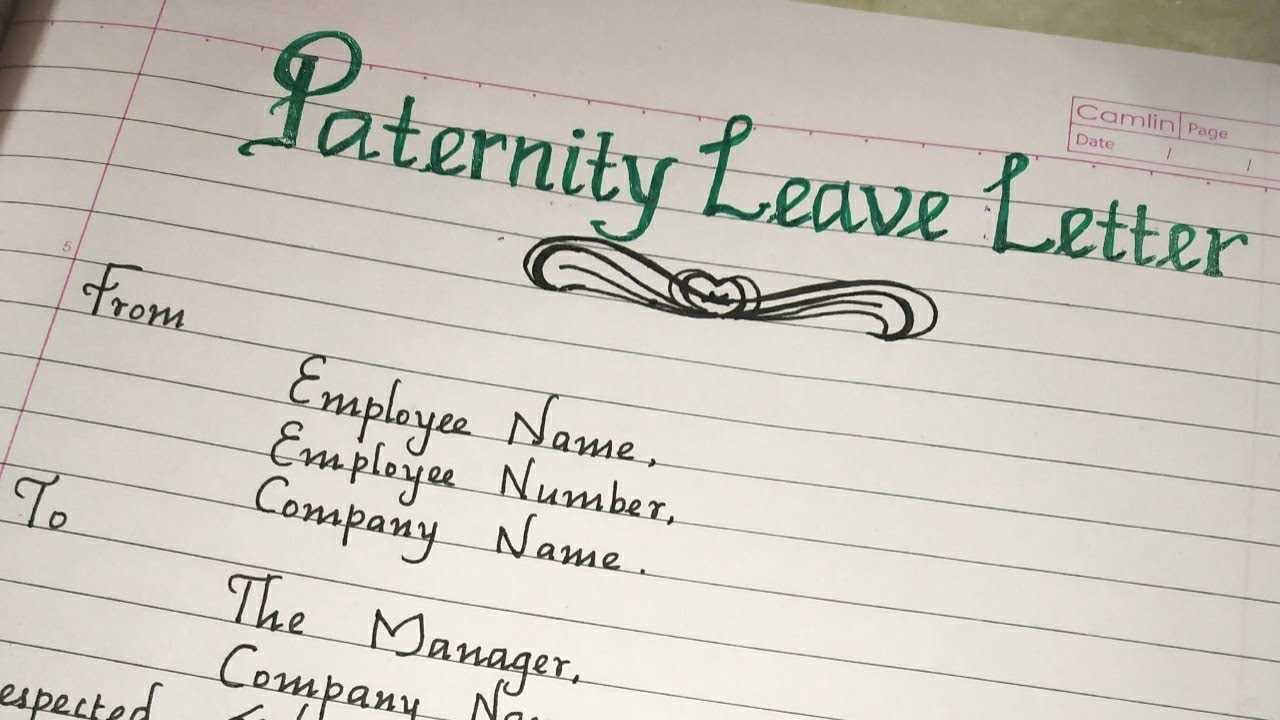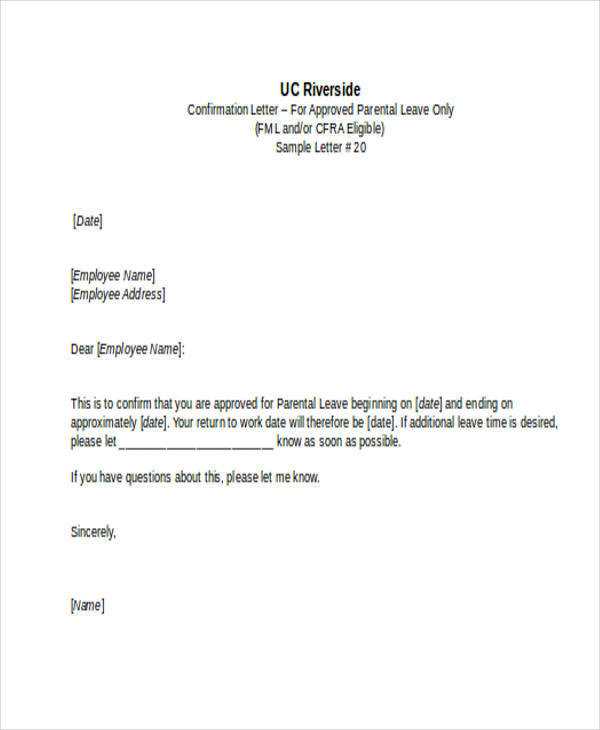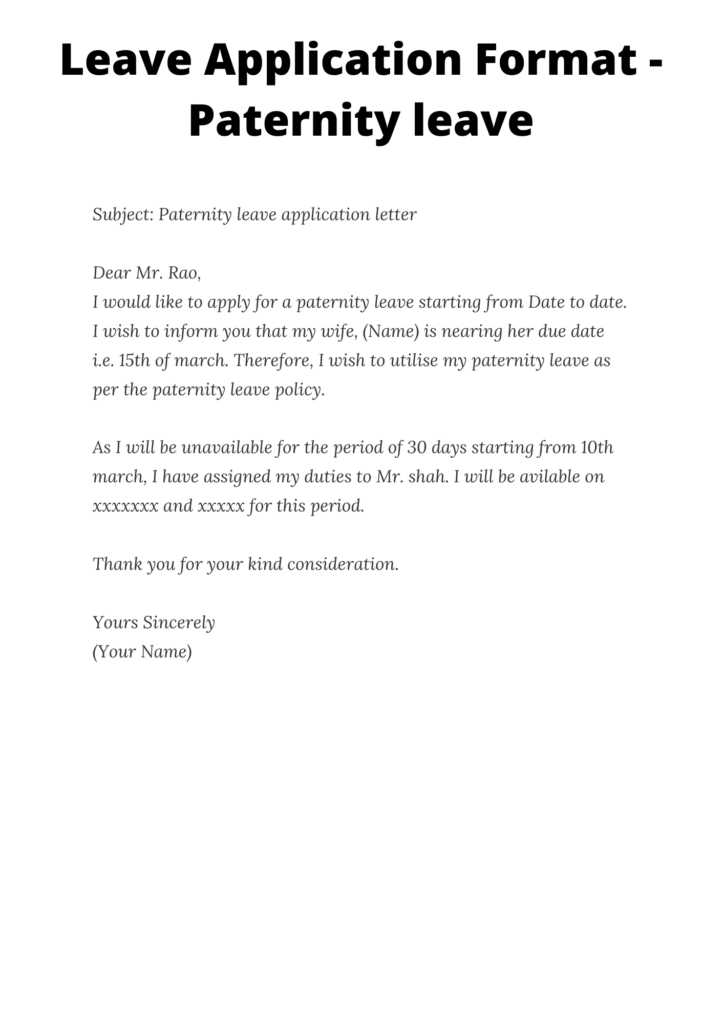Paternity Leave Request Letter Template Guide

When a new family member arrives, taking time off from work becomes a crucial decision. Knowing the proper procedure for informing your employer ensures a smooth transition during this important moment. It’s essential to communicate your plans effectively, balancing professionalism with personal needs.
Having a well-structured document can make all the difference in this process. Clear communication not only reflects your understanding of company policies but also builds goodwill with your employer. Crafting an appropriate message helps maintain a positive relationship while ensuring your absence is properly recorded.
In the following sections, we will explore key points to consider when drafting such a document. From the necessary details to the correct tone, you’ll learn how to present your situation in a clear and respectful manner. With the right approach, this step can be handled with ease and confidence.
Understanding Parental Time Off Policies
When welcoming a new child, it’s essential to understand the policies your employer has in place for time away from work. These policies differ from one organization to another and are often influenced by local laws and industry standards. Familiarity with the guidelines helps you navigate your absence while ensuring that both your personal and professional obligations are balanced effectively.
Before submitting your time-off request, it’s important to review company-specific regulations. Some companies offer paid or unpaid time off, while others may provide flexible options such as partial leave or work-from-home arrangements. Understanding these options is crucial for making an informed decision about your time off.
Key Aspects to Consider
| Aspect | Description |
|---|---|
| Duration | How much time off is granted and under what conditions. |
| Payment | Whether the time off is paid, partially paid, or unpaid. |
| Eligibility | Who is eligible for this time off based on employment duration or position. |
| Flexibility | Whether the time off can be taken in increments or must be taken all at once. |
Legal and Company Guidelines

In many regions, there are legal requirements surrounding time off for new parents. These laws may provide minimum standards, but employers often offer additional benefits. Understanding both the legal framework and your employer’s policies ensures you are aware of your rights and entitlements. Always refer to your employee handbook or consult with HR for up-to-date information on company-specific guidelines.
How to Formally Request Time Off
When planning to take time away from work for personal reasons, it’s essential to follow a formal process to inform your employer. Proper communication ensures that your absence is acknowledged and planned for in advance, minimizing disruptions. This request should be made in a professional manner, outlining the necessary details and respecting company policies.
The first step is to check the company’s guidelines for taking time off. Every organization may have its own protocol, such as providing advanced notice or submitting the request through a specific system. Knowing these expectations will help you prepare the necessary documentation or forms.
Once you have familiarized yourself with the process, the next step is to communicate the dates and duration of your planned absence. Being clear about when you intend to be away and when you will return helps your employer manage your workload in your absence. It’s also helpful to offer any necessary information that would support your absence, such as medical certificates or family circumstances.
Essential Information to Include in a Notification
When submitting a formal notification for time off, it’s important to include key details that ensure clarity and efficiency. This information not only helps your employer understand the reason for your absence but also assists in managing your workload during this period. Providing all necessary details upfront will facilitate a smoother process for both parties.
Start by including the specific dates for when you plan to be absent and when you will return. It’s essential to mention both the start and end dates clearly to avoid any confusion. Additionally, stating the total duration of your absence helps your employer plan for any coverage that might be required.
Another critical aspect to include is the reason for your absence. While this does not need to be overly detailed, a brief explanation can help your employer understand the context. If applicable, you may also want to mention any steps you’ve taken to ensure that your responsibilities are covered during your time away, such as delegating tasks or providing contact information for urgent matters.
Tips for Writing a Professional Request

When composing a formal note to notify your employer about your upcoming time away, it’s crucial to maintain a professional tone. Clear, concise, and polite communication ensures that your message is well-received and that the process goes smoothly. Here are some tips for crafting an effective message.
- Be Clear and Specific: Always include the exact dates of your absence and, if necessary, any relevant details about your situation.
- Use a Polite Tone: Approach your communication with respect and professionalism. Keep the tone courteous, even if you are facing any challenges.
- Provide Necessary Information: Include key details such as the duration of your absence, reason (if applicable), and any steps you’ve taken to ensure work is covered.
- Give Advanced Notice: Aim to inform your employer as early as possible. This allows them enough time to adjust or make arrangements for coverage.
Additionally, be sure to review your message before sending it to ensure it’s free of any errors. A well-written request reflects your ability to communicate effectively and professionally.
Common Errors in Time Off Notifications

When submitting a formal notice for time away from work, there are several common mistakes that can undermine the professionalism and clarity of your communication. These errors can lead to confusion, delays, or even the denial of your request. Being aware of these pitfalls and taking steps to avoid them will ensure a smoother process for both you and your employer.
- Vague or Incomplete Information: Failing to specify the exact dates of your absence or not including a clear end date can lead to misunderstandings and create unnecessary follow-up.
- Last-Minute Submissions: Waiting until the last moment to submit your notice often results in rushed communication. It’s important to give ample notice, allowing your employer enough time to make necessary arrangements.
- Unclear Reasoning: While it’s not always required to go into detail, a brief explanation can help your employer understand the context of your time off. Avoid being overly vague or leaving out important information.
- Failure to Address Coverage: Not mentioning how your responsibilities will be managed in your absence can create uncertainty. Ensure you offer a plan for coverage or delegation of tasks during your time away.
- Overly Casual Tone: While it’s important to be friendly, your communication should always remain professional. An overly casual tone might not convey the necessary level of seriousness.
Avoiding these common mistakes will help you submit a clear, respectful, and effective message. Taking the time to double-check your notification before sending it will ensure that the process is handled smoothly and professionally.
Examples of Parental Time Off Notifications
Providing a clear and formal notification is crucial when you need to take time away from work. Below are some examples of how to structure your communication. These examples serve as a guide for various situations, ensuring that your message is professional and complete.
- Example 1: Simple Time Off Notification
This example is useful for those who just need to inform their employer of their time away, without going into excessive detail.
Dear [Manager’s Name],
I would like to inform you that I will be taking time off from [start date] to [end date] to attend to personal matters. Please let me know if you need any additional information or if there’s anything I can do to assist in preparing for my absence.
Thank you for your understanding.
- Example 2: Request with Coverage Plan
When you want to reassure your employer that your responsibilities will be handled during your absence, this example includes a plan for coverage.
Dear [Manager’s Name],
I am writing to inform you that I will need time off from [start date] to [end date] for personal reasons. During this time, [Colleague’s Name] has kindly agreed to take over my responsibilities, including [specific tasks]. Please don’t hesitate to contact me via email if anything urgent arises.
Thank you for your support in this matter.
- Example 3: Extended Absence Request
This example is for individuals planning an extended absence and provides a more detailed explanation of the situation.
Dear [Manager’s Name],
I would like to request time off from [start date] to [end date] due to [brief reason for absence]. This period will allow me to attend to family matters, and I will ensure all my tasks are completed or delegated before my departure. If necessary, I will remain accessible for urgent issues.
Thank you for your understanding and support.
These examples highlight the different ways you can communicate your need for time off. By adjusting the level of detail and tone based on your specific situation, you can ensure your request is clear, professional, and respectful of your employer’s needs.